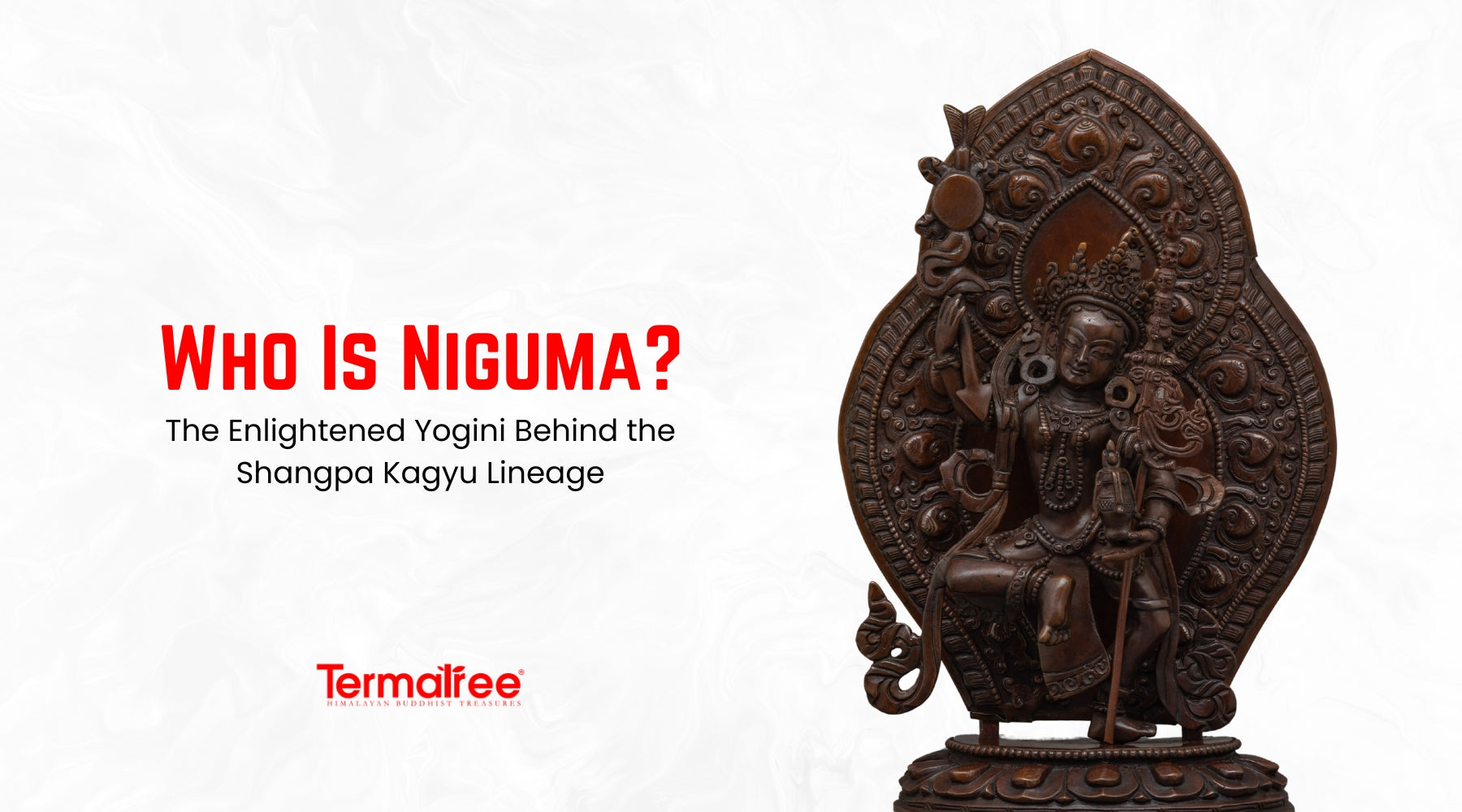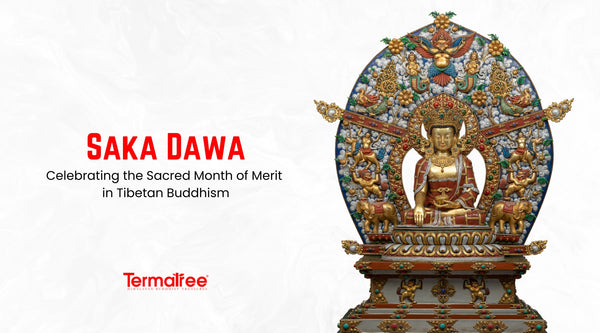Introduction to Niguma and Her Contributions to Vajrayana
In the vast and complex world of Vajrayana Buddhism, few female figures do as much shining as Niguma, a powerful yogini, dakini, and spiritual master whose teachings established an entire lineage. Considered to be the spiritual consort/sister of the Indian mahasiddha Naropa, she was a pioneer, establishing the Shangpa Kagyu lineage and passing on extensive teachings, which are primarily hidden teachings of tremendous depth, called the Six Yogas of Niguma. Although she has remained in the shadows of more widely acknowledged male masters for a long time, the past few years have seen a greater acknowledgement of the immense spiritual contribution of this dakini.
This blog offers a full introduction to Niguma's life and teachings, and contributions to the Vajrayana tradition, drawing from Tibetan sources and respected contemporary interpretations.
Who Was Niguma?
A Mysterious and Enlightened Yogini

Niguma's historical persona is somewhat obscured. According to the method of production records, she lived in the 10th or 11th century CE, and is often referred to as a sister or consort of Naropa, one of the pivotal figures of the Kagyu school of Tibetan Buddhism. Whether or not there is a familial relationship has been debated by Western scholars, some of whom contend that she was not Naropa's biological sister. Regardless of her familial relationship with Naropa, the accounts in Tibetan tradition suggest that they shared an unbreakable spiritual connection.
The name Niguma (Nigupta or nigu) is translated to 'Goddess of Illusion' or 'She Whose Reveals the Illusory Nature of Phenomena.' She is depicted in yogic postures, either sitting in meditative equanimity or dancing in wrathful dakini form, suggestive of her ability to transform on the inside.
Enlightenment Through Tantra
Niguma realized complete enlightenment through Tantric processes as well as meditation. Tibetan hagiographies describe that she had appeared as a rainbow body, and eludes form altogether and only leaves teachings. Her enlightenment was not merely theoretical or scholastic—it was also experiential and transformative, and thus became the origin of a living tradition.
The Life and Origins of Niguma
While concrete historical details about her are few, Tibetan Buddhist tradition tells us that she was born in Kashmir, one of the learning and spiritual epicenters of her day. Her relationship with Naropa, whether as sister, consort, or close spiritual peer, is evidence of her deep entwinement in the great lineage of Indian mahasiddhas.
Niguma's line was distinctive. She, along with many great teachers, taught openly and formally in a monastic environment, yet she also emphasized direct reception of teachings through phenomenological experience and close discipleship. Her key student, Khyungpo Naljor, encountered Niguma's teachings during his travels in India. In private, she initiated him in secret rites that planted the seeds of the Shangpa Kagyu lineage.
Her transmission, with another female master, Sukhasiddhi, emphasized experiential wisdom over textual study. They only transmitted their practices of awakening through the illusion of reality, dream yoga, and Mahamudra practice in person and without written context, to safeguard the purity of their teachings over time.
Although her life represents an underdeveloped background and not much work exists from her hand, it nonetheless shows the hidden yet formidable sovereignty of female spiritual power in Vajrayana Buddhism. The subtlety of her work and the covert nature of her practice exemplify the vast potential of a yogini engaged in the vast expanse of Tibetan tantric tradition.
Niguma’s Iconography and Symbolism
-
Niguma sits in Lalitasana (royal ease), having conquered samsara and sitting relaxedly in control of illusion and wisdom.
-
Her meditative expression, with eyes slightly downcast, shows calmness from inner realization, clear spiritual thinking, and dakini compassion.
-
Her five-leaf crown represents the Five Dhyani Buddhas, each representing the purification of the five aggregates, showing that she is in an enlightened state.
-
The damaru (hand drum) in her right hand represents the sound of emptiness, inviting wisdom dakinis and the union of method and wisdom.
-
The kapala (skull cup) in her left hand represents the transformation of ignorance into blissful wisdom and being present with impermanence.
-
Beside her lies a khatvanga staff, which represents her union with enlightened consort energy and complete tantric realization.
-
The ornaments she wears and the flowing silks she drapes represent the Six Perfections, and confirm her identity as a fully realized dakini of both beauty and wisdom.
-
Behind her, the torana (aureole) represents the radiate energy of spirit, and explains the boundary between the mundane world and the enlightened space.
-
She sits on a double lotus pedestal, which represents spiritual purity, being unattached, and the realization of both method and wisdom.
Niguma and the Founding of the Shangpa Kagyu Lineage
Transmission to Khyungpo Naljor
Niguma's most profound contribution to the Tibetan tradition of Vajrayana Buddhism can be considered her transmission of secret teachings, called "Vajrayana," to the Tibetan yogi named Khyungpo Naljor. Khyungpo Naljor was a scholarly and earnest practitioner who traveled to India to seek true, authentic spiritual teachings. After receiving myriad initiations and transmissions, he came to her in a cemetery charnel ground that possesses highly significant symbolic value in tantric Buddhism.
She agreed to teach him, but only after he showed he could purify his mind and made a commitment to her as well. During their time together, she transmitted much of her teachings to him, including her own version of the Six Yogas, which are parallel to Naropa's but different in nuance. The teachings would turn into the Shangpa Kagyu lineage of Vajrayana Buddhism. It is referred to as the "secret lineage" because it was only passed down through one or two disciples for several generations.
Why the Lineage Was “Secret”
In contrast to the other more widely known Dagpo Kagyu lineages (such as the one from Marpa and Milarepa), from which there may be many replicas today, the Shangpa lineage was secretive at its origin in order to preserve the purity of the teachings. For seven generations, the Shangpa lineage was practiced through a one-to-one relationship with a master, with the intent to minimize any chance of distortion or dilution of the teachings. Niguma's desire to confer all the empowerment to a single disciple - Khyungpo Naljor - is indicative of the yogini’s faith and trust in Khyungpo Naljor's status of spiritual maturity for the integrity of the Dharma.
The Six Yogas of Niguma
An Esoteric System of Advanced Practice
One of Niguma's most durable gifts to Vajrayana Buddhism is her specific wording of the Six Yogas. These practices aim to transform ordinary perception into enlightened awareness and are typically undertaken as advanced practices by practitioners who have completed ngöndro.
The Six Yogas of Niguma are:
-
Tummo (Inner Heat Yoga)
-
Illusory Body Yoga
-
Dream Yoga
-
Clear Light Yoga
-
Bardo Yoga (Intermediate State)
-
Phowa (Consciousness Transference)
While these practices also appear in the Six Yogas of Naropa, Niguma's version has diverse emphases and visionary practices. For example, her teachings are more explicit when discussing the illusory nature of manifestations as it relates to the Mahayana view of emptiness (shunyata) presented as the affective energetic wisdom aspect of that emptiness as well as doing the Tantric deities of the yogas in relation to their subtle body practices. It is also meant to be a unitive, visionary, meditative absorption.
Uniquely Feminine Perspective
Niguma's description of these yogas is not a retelling of Naropa's system. There is a feminine wisdom perspective - a tremendous amount of emphasis of compassion, space, and subtlety - derived from a feminine loving satwistic quality that works very nicely compared to more "masculine" Tantric methods of clarity, definite form, and boundary.
In addition, the yogini’s teachings are grounded in experiential realization from yogically mediated experience, yogic protocols, and surrendering with devotion. Niguma even encourages students to use their direct experience in ways to help them go beyond conceptualization, which allows practices that can dissolve the ordinary self and reveal the implicate luminous state of the mind.
A Feminine Paradigm of Vajrayana Realization
Niguma's teachings introduce a unique and powerful female voice in Vajrayana Buddhism, a lineage that is rich with female imagery but in which human women have rarely played a visible role as a lineage holder. Though some figures have been positioned as consorts and symbolic inspirations, Niguma stands as a realized master in her own right: a dakini-guru, visionary yogini, and transmitter of profound esoteric teachings. She is not an accessory or extension of male power, but instead an origin, a source, an awakening, and wisdom. Her life embodies the reclaiming of a tantric ideal that ultimate realization is possible for women in a way that is not only theoretically possible, but as realized truths.
Though Naropa is often made prominent in historical narratives, Niguma's own six dharmas reveal a depth and nuance that is uniquely her own, specifically highlighting the illusory body, dream yoga, and the mind as light. Her path stresses the subtle, the spacious, and the vision—transforming the practitioner's views, not just through technique, but through direct, intuitive knowledge. Her teachings developed from meditative retreat, from symbolic language, from direct experience—none of which aspire to categorize, as they are all part of the dakini tradition. In this light, it is fair to say not only does Niguma embody feminine energy, but she also embodies wisdom--alive, awake, and radically embodied.
Despite intentionally keeping her lineage small for centuries, Niguma's voice is growing louder in a relatively modern world where many seekers are seeking a spiritual path that is balanced, inclusive, and ultimately embodied. She is not just a historical first source of inspiration for female practitioners, but an invitation to all seekers to honor wisdom in its fullness. Her presence reminds us that the highest realization has nothing to do with form, gender, or notoriety; it is a matter of inner clarity, heartfelt compassion, and willingness to dissolve dualistic separateness.
Legacy and Revival of Niguma’s Teachings
The Shangpa Kagyu's Reemergence
Following several centuries of relative obscurity, the Shangpa Kagyu lineage (and consequently Niguma's teachings) has recently had a renaissance in the last few decades, primarily through the work of Tibetan lamas in exile. In the 20th and 21st centuries, individual masters such as Tenga Rinpoche, Kalu Rinpoche, and many others have made these teachings more accessible via empowerments, retreats, and commentaries in Tibet and in the West.
This has led to an increase in interest in Niguma not only as the ultimate source of these essential practices, but also as a spiritual figure for contemporary practitioners (and especially women) who are seeking empowered female figures in Buddhism.
Western Centers Dedicated to Her Legacy
The Sukhasiddhi Foundation continued to uphold Niguma's views and practices while propagating many aspects of female enlightenment, yogic training, and tantric knowledge derived from her lineage. At this center, they honor Niguma not only as a historical master, but as a fully living teacher—an embodiment of a dakini—who teaches Buddhist practices that are practical, possible, and transformative. Through such centers, Niguma's Six Yogas and other esoteric instructions will continue to be traditionally preserved, while having an authentic contemporary presentation that is both digestible and respectful of postmodern expectations.
Niguma’s Relevance in Modern Vajrayana Practice
A Symbol of Empowered Female Enlightenment
In a male-centered tradition, Niguma’s enlightened status is a powerful statement that women can be gurus, lineage-holders, and tantric practitioners. The story of her life expands stereotypes and opens us up to a broader understanding of spiritual realization.
More modern practitioners are beginning to regard Niguma as a representation of feminine strength, intuitive awareness, and yogic power. Her example can inspire not only nuns and yoginis but also male practitioners who wish to approach Vajrayana practice with balance, compassion, and spaciousness.
Psychological and Spiritual Applications
With her messages, particularly her emphasis on understanding the self and the world as illusory, Niguma’s teachings theoretically align with modern psychology and mindfulness. These techniques are also consistent with non-duality awareness, lucid or intentional dreaming, and somatic transformation practices, offering the modern seeker tools to navigate experiences in their internal and external worlds.
Why Niguma Matters Today
Niguma is a rare representation of non-dual realisation and spiritual balance associated with both masculine and feminine energies – both clarity and compassion, both method and wisdom. With the present craving for women's voice in the spiritual realm, it is also a position for offering the universal model of non-dual realisation—a distinction that includes all parts of experience. For female practitioners, she presents an archetype of empowerment: not a symbolic dakini, but an entirely awakened guide, and a path for themselves.
Beyond gender, Niguma's practices suggest so many of the contemporary areas of interest, such as mindfulness, depth psychology, and shadow work—her interconnected practices of dream yoga, illusory body practice and subtle body awareness offer real tools for making your ordinary life a path to awakening and transformation, and she is an excellent teacher for spiritual integreation who offers embodied and practically oriented spiritually integrated approaches.
As we move towards a demand for more authentic and spiritually inclusive pathways, Niguma, the dakini of our time, reaches out to us in the present. It becomes clear that through her teachings, the boundary between what is outside and what is inside us dissolves, between what is self and what is an illusion, illuminating the way for those ready to meet themselves.
Conclusion: Niguma, the Illuminating Dakini of Vajrayana
Niguma's hidden, massive legacy is well known. As the founder of the Shangpa Kagyu lineage and the originator of the Six Yogas of Niguma, she shaped the tantric landscape of Tibet and contributed to the ongoing history of centuries. She was more than Naropa's consort or muse; she was her own brilliant teacher, receiving visionary teachings from Vajradhara and, with clarity and ferocity, transmitting them. Her authority came from experience and the emergence of her own as a clear practitioner of the truth-doing practice in solitude, undergoing astounding realization, and abiding in the dispositions her practice established as a priority and commitment in her life. Through her, students, dakinis, yogis, and other seekers have discovered method and inspiration toward awakening.
In a historical context that often confines women to purely symbolic or niche roles, Niguma offered a powerful exception, not as a revolt, but as a revelation. Her life is the sadhana: a human life and direct experience that is a clear manifestation of divine knowledge. Her teachings support the view that the dream-like quality of the world is not an error to be escaped, but rather a medium with which awareness can dance freely. Niguma does not belong to the past—she is a teacher of our time.
To have her in the Vajrayana canon corrects much, not as a limited, exclusive view, but towards wholeness and inclusivity. In the illusory world, she has been given the clear light path; in the culture of noise, she speaks through silence; and in the body of every sincere practitioner, her wisdom lies in wait to be remembered as the very nature of mind, not as doctrine.






2 comments
📉 Email- + 1,421981 BTC. Verify >> https://yandex.com/poll/enter/BXidu5Ewa8hnAFoFznqSi9?hs=9f533e8d215abea896342bce17424b90& 📉
cqc3nj
🗒 + 1.989898 BTC.NEXT - https://yandex.com/poll/7HqNsFACc4dya6qN3zJ4f5?hs=9f533e8d215abea896342bce17424b90& 🗒
dhgsfj